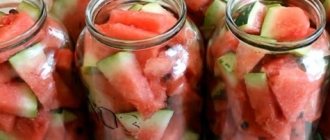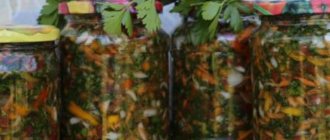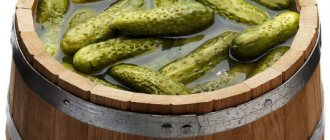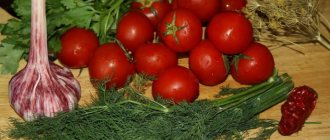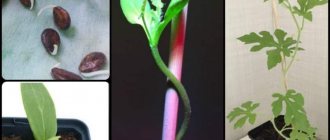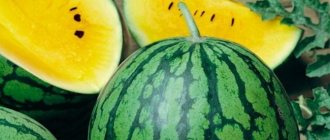How to pickle delicious watermelons according to grandma's recipe? The common method of preservation is different and is used differently by each family. Wooden or plastic barrels are used, preservation is stored until the summer season in a cool place.
Sliced berries on a plate
Watermelons are cut into pieces or harvested whole and have a sour, salty or sweet taste.
Spices used:
- Mustard.
- Sugar.
- Salt, etc.
Requirements:
- Pink berries are ideal for sourdough.
- Overripe ones are not used, their pulp becomes viscous and loses its taste.
- The peel is intact without damage.
- The flesh in the center is dense.
Watermelons in a barrel are salted according to grandma's recipe at the beginning of autumn, when the summer heat subsides. Such conditions promote good fermentation.
Whole pickled watermelons in a barrel
Pickles in a wooden barrel
The storage container is washed with boiling water, berries with an average width of 15 cm are placed there. To speed up the fermentation, the skin is pierced with a knitting needle or fork at different points symmetrically. All berries are filled with brine, which is prepared from the following ingredients:
- Salt – 500 g per 10 liters of water.
- The same amount of sugar.
The liquid gets a sweetish taste with a slight sourness, so that the pulp is rich, 300 g more salt is used, and 100 g less sugar.
Watermelons always float, the recipe requires that they be under water; for this, oppression is used and a flat lid is slightly narrower in diameter than the neck of the barrel. The first few days the storage temperature should be about 20 degrees, then the barrels are moved to a cold basement.
Which watermelons are suitable for salting?
You should choose late varieties, such as Vesenniy, Kustovoy 334 or Ikar. All of them are quite suitable for salting or pickling. But, first of all, you should choose the right fruits. They shouldn’t be too ripe, and if they turn out to be a little underripe, that’s even better. The main thing is that the watermelons have juicy pink flesh and no defects on the skin (try to choose ones that do not have darkened or soft areas). Preference should be given to fruits whose weight does not exceed 2 kilos.
Watermelons for pickling
Small berries are also very good for storing for future use, if they have already gained some sweetness. In particular, many gardeners use varieties of watermelons with small fruits for salting, even early ripening ones, for example, such as Sugar Baby. The main factor when choosing a variety is the thin peel. It is also desirable that the pulp is not too crumbly. The juice content in melons also plays a significant role; it must be high enough for the preparation to be tasty.
With chopped cabbage
Cabbage for sourdough
A 10 cm layer of chopped cabbage is placed in a barrel, fruits are laid on top, then chopped vegetables again. Use 60 g of cabbage per 1 kg of watermelons, grandmother’s cooking method allows for the use of apples and green tomatoes, watermelons should not touch.
To prepare the brine, salt and sugar are poured into the water in the proportion of 0.5 kg of each component per 10 liters of liquid. In a warm place, the barrel is stored at 20-22 degrees for 2 days, then moved to the cellar. It is recommended to consume watermelons made using this method before mid-January.
After watching the video, you can learn how to pickle watermelons in a barrel according to your grandmother’s recipe.
Recipes for watermelon preparations for the winter
There are many recipes for making salted watermelons: traditional in a barrel, with herbs, vegetables, fruits. There is even a method of pickling with sauerkraut. Rinse the prepared container with boiling water twice. Each recipe has its own nuances, but they are united by one common algorithm:
- the container is 2/3 filled with even rows of berries;
- the brine is poured so that it covers all the fruits and about 7 cm on top;
- the barrel with pickled watermelons is closed with a lid, which is slightly smaller in size than the neck;
- a weight is placed on the lid that is heavy enough so that the berries do not float, but not excessive so as not to turn the watermelons into mush.
For the first 2 days, the pickling is kept warm - this will start the fermentation process, then it is hidden in a dark, cool place.
Important! During the fermentation process, mold forms and must be removed. Therefore, barrels with pickling must be checked at least once every 5-7 days. In addition, the brine needs to be added.
Whole barrel fruits
Each recipe is based on a traditional recipe. The only differences are in the choice of additives and changing the proportions of salt and sugar. Pickled watermelons retain their beneficial qualities if they are placed whole in a barrel. Which recipe to choose, and how exactly to pickle watermelons in a barrel for the winter - whole or in pieces - depends solely on personal taste preferences.
Classical
To salt watermelons for the winter, you need to dissolve 800 g of salt in 10 liters of water and pour this brine into a barrel of berries. The salting is covered with a lid on which the press is placed. The workpiece is stored warm for 48 hours and then put into the cellar. Readiness is checked after 21 days.
With cabbage
In this preparation, layers of watermelons alternate in a barrel with salted cabbage. Remove the top leaves from the head of cabbage, chop finely, add salt (60 g of salt per 1 kg of cabbage), and mash with your hands. The first layer is cabbage, about 15 cm. Next, watermelons are laid out: they should not touch each other or the walls of the container, for this a layer of cabbage is made between them, and all the pickling is covered with it from above.
The container with the workpiece is covered with gauze or any clean cloth, and a load is placed on top. Storage - as in all other recipes: 2 days in a warm place, then in the cold. After a month, you can take a sample, but you need to use it within six months.
With apples
To prepare salted watermelons in a barrel with apples you will need:
- salt – 750 g;
- apples of any variety – 5 kg;
- currant leaves – 15 pcs.;
- straw.
Rinse the straw with cool water and scald. The space between the watermelons is filled with apples, and straw and leaves act as a layer. Next, everything is done according to the traditional scheme: the container is filled with a solution, a weight is placed on the lid and the salting is put away in a dark place. The readiness of the workpiece can be checked after 2-3 weeks.
It will take 3 months to prepare pickled watermelons. The fruits are small - no more than 25 cm in diameter. Line the bottom of the barrel with grape leaves, and place watermelons on them in rows. Fill the resulting voids with apples. Add equal amounts of salt and sugar (500 g each) to 10 liters of water and pour this brine over the watermelons. Cover the container with a clean cloth, sprinkle mustard powder on top, and close with a lid. Place a weight on top and put it in the cold. Every 5-7 days you need to remove mold and renew the fabric.
With garlic
To enrich the taste of the dish and add piquancy to it, garlic, horseradish, and spices are added to the barrel with the appetizer. It's easy to prepare this dish at home. Berries for pickling alternate with peeled garlic cloves.
Other seasonings can be added if desired: horseradish root, mint. Standard brine: 400 g salt, 500 g sugar, 10 liters of water. Any seasonings you like are added to it. For example, allspice, cinnamon, mint. All ingredients are mixed and the resulting solution is poured over the berries. The workpiece is placed under a press, kept warm for a day, and then put away in the cellar. The savory snack will be ready in a month.
With hot pepper and herbs
You can prepare an interesting dish that gourmets will like if you experiment with spices. For example, chili peppers, garlic, and various herbs add a spicy taste. To ferment watermelons and get an unusual taste, dill, parsley, celery root, and nutmeg are added to the barrel. Garlic cloves are evenly placed in the space between the watermelons. Hot pepper pods are also placed in the container.
The brine is traditional: for 10 liters of water, the same amount of salt and sugar - 500 g each, as well as bay leaves, peppercorns, and any other spices to taste. Place the brine on the fire and bring to a boil. Remove from heat, cool and pour over prepared watermelons. Cover with a lid and press. The workpiece is stored warm for a day and then removed. Ready time – 3 weeks.
With mustard
The advantages of a recipe for pickled watermelons with the addition of mustard powder to a barrel are protection against the formation of fungus and an increase in the shelf life of the snack. To the traditional brine (10 liters of water, 400 g of salt) add 50 g of mustard. However, you can change the taste at your discretion, for example, make it richer by adding 400 g of sugar and increasing the salt to 800 g. You can try the dish for 3-4 weeks.
In watermelon juice
To prepare this option, you will need not only whole fruits, but also pulp.
Required:
- 10 kg of fruits weighing 2-3 kg;
- 60 g salt;
- 5 kg watermelon puree.
The algorithm is like this:
- Prepare watermelon puree. To do this, wash and cut the berries. Peel them and remove seeds, mash them into a puree using a blender. Add salt, stir.
- Place fruits mixed with watermelon puree in a container for pickling. In this case, the lowest layer and the top one are made from pulp.
- Cover the barrel with a clean cloth and refrigerate for a week. Check for mold formation and add solution as needed.
After a month, the watermelons in their own juice are ready; they can be stored in a barrel in a cool room for about six months.
With apples
Sourdough with apples
This method requires more time, preparation will be completed in 3 months. To be in time for the New Year, it is better to do preservation at the very beginning of autumn.
Ingredients:
- Delicious watermelon with a diameter of up to 25 cm – 3 pcs.
- Boiled water – 10 l.
- Apples – 1 kg.
- Mustard.
- Cherry or grape leaves.
Any apples you like are suitable for sourdough. First, petals are placed in the barrel, then watermelons, and apples are inserted into the empty spaces. All ingredients are laid out in layers until the container is filled, taking into account the specified proportions.
For the starter, a traditional solution of salt and sugar is prepared. Watermelons are poured, covered with a cloth, mustard powder is poured on top, a lid is placed on it, and pressure is applied. Every 7 days, the mold is removed, a clean cloth is placed, and the berries are stored in this form for 3 months.
With hot pepper and herbs
Hot pepper and other spices
For 5 kg of berries the following amount of ingredients is used:
- Water – 3 l.
- Salt and sugar - 170 g each.
- Hot red or green pepper – 1 pc.
- Garlic – 1 head.
- Greens – 50 g.
The fruits are cut into slices, the barrel is filled with brine. It is advisable to pour spring water without chlorine; all ingredients are laid in layers, filling the space between the berries. The load is always placed on top carefully so as not to crush the pulp. Then the barrel is moved to a cool basement.
With mustard
Mustard for brine
A 100 liter barrel is filled with the following components:
- Watermelons up to 20 cm wide – 20 pcs.
- Mustard seeds or powder – 0.5 packs.
- Sugar – 100 g.
- 10 liters of water.
Watermelons are sorted, approximately the same ones are selected, 2-3 kg each, the stalks are cut off.
Mustard seeds are added to the brine; if powder is used, you must wait until the granules are completely dissolved. The pickles will be ready after 3 weeks.
Another video recipe
Ready pickled watermelon
To better understand how to pickle watermelons in a barrel, you can see the detailed instructions.
A pleasant taste of pickles can be obtained if all the ingredients are followed.
Other components:
- Garlic.
- Allspice peas.
- Cloves, etc.
Storage containers are sold in hardware stores; it is recommended to use large oak barrels.
General rules for pickling watermelons
For harvesting, you should take fruits of late-ripening varieties weighing no more than 3 kg. Watermelons should be slightly unripe or ripe, but not overstayed, with fairly dense flesh, intact, without cracks, dents or other damage.
with a thin rind are best suited for pickling . If the berries you have chosen turn out to be “thick-skinned,” the rind will have to be cut off, leaving only part of the white layer no more than 1 cm thick. The thin rind is not removed, but when harvesting whole watermelons, it is pierced in 10-15 places with a steel knitting needle or needle to make it easier the process of brine penetration inside.
When salting, the thin rind of watermelons is not cut off so that the pieces retain their shape better.
According to the classic, “grandmother’s” recipe, salted watermelons can be prepared using only three ingredients: the fruits themselves, water and rock salt . However, housewives, trying to diversify the taste of the final product, add spices (sugar, vinegar or citric acid), spices (bay leaf, peppercorns, ground chili pepper, nutmeg, etc.), fresh garlic and ginger root to the brine, and also dill, celery, tarragon, cherry or black currant leaves.
The required amount of brine directly depends on the size of the parts into which the watermelon is cut. The larger the slices, the more liquid will be used to fill them. If watermelons are pickled whole, for each fruit weighing about 2 kg you need to prepare about 1.5 liters of salt solution.
Preparation
For good fermentation, wooden containers are used. These convenient containers are suitable for sweet fruits and berries, retain their taste, and the pickles smell pleasant.
Rules for preparing barrels:
- Barrels are washed without chemicals.
- Treated with boiling water from the inside.
- Cover with cotton cloth and place in a warm room.
- The inner surface must be protected from dust.
Preparing watermelons:
- The skin is washed and dried.
- It is pierced with a needle in 10 places symmetrically.
They are carefully placed in the barrel so that cracks do not appear.
How to prepare barrels
If you want the salting of watermelons in barrels for the winter to be successful, then use a wooden container for this. This technique allows you to easily pickle even the sweetest fruits, while preserving their pleasant aroma and taste. The barrels must be properly prepared for this. Namely:
- rinse them thoroughly, preferably with cold water, without using chemicals;
- scald the wooden surface with boiling water;
- then you should cover the containers with a towel and place them in a closed but warm enough room;
- It is important that no dirt or dust gets into the barrels.
Plastic and stainless steel barrels
Plastic barrel for sourdough
Instead of wooden barrels, plastic ones are used. The material must be compatible with food products and not react with the contents. Low-quality plastic releases harmful chemicals, and pickles absorb them. This property must be clarified when purchasing.
Stainless steel and galvanized containers are suitable. Aluminum cannot be used, the metal quickly reacts with the contents, and the products will quickly deteriorate.
The recipe for making pickles is similar, but the taste may differ, since the oak barrel imparts its specific aroma to the pickles. If the plastic container is chosen incorrectly and is not suitable for storing food products, the berries will begin to absorb chemical reagents that change the properties of the pulp after interacting with the brine.
Stainless steel is also recommended to be used in extreme cases. Brine corrodes the highest quality material, so such containers are only allowed to be used in extreme situations, if there is no other way to pickle the fruit. The quality of stainless steel should be the highest; the surface of the material should not release trace elements under the influence of salt and other components in solution.
Can I use a plastic barrel?
If you don’t have a wooden barrel on hand, you can use a plastic one. The recipe for pickling watermelons in a barrel made of this material is the same as for a wooden container. But you should be prepared for the fact that the fruit may not acquire the best taste. Plastic is an artificial material, so it contains many harmful substances. In addition, watermelon, like a sponge, absorbs all foreign odors, which under the influence of salt water intensify even more.
In the countries of the former USSR, one of the common types of preparing snacks is pickling watermelons in a barrel. Each family has its own special recipes for pickling them: apples and cabbage are added to watermelons for pickling, and a variety of spices and herbs are used. The container can be either wooden or plastic. The salted fruit will decorate not only an everyday meal, but also a festive feast.
Pickled and salted watermelons are prepared exclusively without the use of vinegar. The fermentation process involves the lactic acid bacteria contained in watermelons, while pickling requires the use of vinegar.
Both pickled and pickled berries have their own taste benefits, but watermelons prepared by pickling in barrels are the most beneficial for the stomach. They retain substances beneficial to the body. The disadvantage of this method is the need for a cellar or utility room where you can install a barrel of pickles.
Glass jars
Sourdough in a jar
To place the fruits in such a container, you must:
- Separate them from the peel and cut the pulp into cubes.
- Pour in brine.
- Store at room temperature for 2-3 days before fermentation begins.
- Roll up the cans.
- Transfer to a cool basement.
Suitable temperature is 0 - +3 degrees. The berries will remain in this mode until spring.
